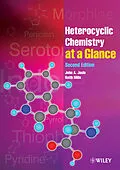This expanded second edition provides a concise overview of the main principles and reactions of heterocyclic chemistry for undergraduate students studying chemistry and related courses. Using a successful and student-friendly "e;at a glance"e; approach, this book helps the student grasp the essence of heterocyclic chemistry, ensuring that they can confidently use that knowledge when required. The chapters are thoroughly revised and updated with references to books and reviews; extra examples and student exercises with answers online; and color diagrams that emphasize exactly what is happening in the reaction chemistry depicted.
Autorentext
Professor Emeritus John Joule, Chemistry Department, The University of Manchester, UK
Professor Joule worked for 41 years at the University of Manchester before being appointed Professor Emeritus in 2004. Sabbatical periods were spent at the University of Ibadan, Nigeria, Johns Hopkins Medical School, Department of Pharmacology and Experimental Therapeutics, and the University of Maryland, Baltimore County. He was William Evans Visiting Fellow at Otago University, New Zealand. He has taught many courses on heterocyclic chemistry to industry and academe in the UK and elsewhere. He is currently Associate Editor for Tetrahedron Letters, Scientific Editor for Arkivoc, and Co-Editor of the annual Progress in Heterocyclic Chemistry. He is co-author with Keith Mills of the leading textbook in the field, Heterocyclic Chemistry (Wiley, 5th Edition 2010).
Dr Keith Mills, Independent Consultant, UK
Dr Mills worked in Medicinal Chemistry and Development Chemistry departments of GlaxoSmithKline for a total of 25 years. Since leaving GSK he has been an independent consultant to small pharmaceutical companies. Dr. Mills has worked in several areas of medicine and many areas of organic chemistry, but with particular emphasis on heterocyclic chemistry and the applications of transition metal-catalysed reactions. With John Joule he is co-author of the leading textbook in the field, Heterocyclic Chemistry (Wiley, 5th Edition 2010).
Klappentext
Heterocyclic chemistry is a central part of organic chemistry and biochemistry, dealing with a particular set of chemical structures; organic compounds with a ring structure containing at least one heteroatom (commonly nitrogen, oxygen or sulfur).
Heterocyclic Chemistry at a Glance, Second Edition provides both an introduction and summary of the main principles and reactions of heterocyclic chemistry, for students studying chemistry and related courses at undergraduate level.
This second edition has been much expanded, allowing for a more thorough treatment of key principles and the inclusion of extra examples and illustrations, including heterocycles used in electronics, explosives, polymers, dyestuffs, pigments and that occur in food. All chapters have been revised and updated, including references to books and reviews, and student exercises, with answers on line at http://booksupport.wiley.com. New to this edition is the use of colour in schemes and diagrams highlighting parts of products (or intermediates) where a change in structure or bonding has taken place.
Based on the highly successful and student-friendly "at a glance" approach, the material developed in this book has been chosen to help the student grasp the essence of heterocyclic chemistry, ensuring that they can confidently use that knowledge when required. The structure of the book allows for quick assimilation, understanding and recall of key concepts, facts and definitions, providing an invaluable aid to revision for students preparing for examinations.
Reviews for the first edition:
"This book can be recommended to students looking for a textbook on heterocyclic chemistry. The organization of the material is oriented towards the needs of undergraduate students, but nevertheless the book is comprehensive and will also be of value for more advanced readers."
Heterocycles
Chemistry World
Inhalt
Biography v
Abbreviations xii
Introduction to Second Edition xiv
1. Heterocyclic Nomenclature 1
Six-membered aromatic heterocycles 2
Five-membered aromatic heterocycles 2
Non-aromatic heterocycles 3
Small-ring heterocycles 3
2. Structures of Heteroaromatic Compounds 4
Structures of benzene and naphthalene 4
Structures of pyridines and pyridiniums 5
Structures of quinolines and isoquinolines 6
Structures of diazines (illustrated using pyrimidine) 6
Structures of pyrroles, thiophenes and furans 6
Structure of indoles 8
Structures of azoles (illustrated using imidazole) 8
3. Common Reaction Types in Heterocyclic Chemistry 9
Introduction 9
Acidity and basicity 9
Electrophilic substitution of aromatic molecules 10
Nucleophilic substitution of aromatic molecules 13
Radical substitution of heterocycles 14
C-Metallated heterocycles as nucleophiles 15
Generation of C-metallated heterocycles 16
Dimethylformamide dimethyl acetal (DMFDMA) 17
Formation and hydrolysis of imine/enamine 18
Common synthetic equivalents of carbonyl compounds in ring synthesis 19
Cycloaddition reactions 19
4. Palladium in Heterocyclic Chemistry 21
Palladium(0)-catalysed (and related) reactions 21
Addition to alkenes: the Heck reaction 26
Carbonylation reactions 26
Cross-coupling reactions between heteroatom nucleophiles and halides - making carbon-heteroatom bonds 27
Triflates as substrates for palladium-catalysed reactions 27
Mechanisms of palladium(0)-catalysed processes 28
Reactions involving electrophilic palladation 29
Copper-catalysed amination 30
Selectivity 31
5. Pyridines 33
Electrophilic addition to nitrogen 33
Electrophilic substitution at carbon 34
Nucleophilic substitution 35
Nucleophilic addition to pyridinium salts 36
C-metallated pyridines 37
Palladium(0)-catalysed reactions 39
Oxidation and reduction 39
Pericyclic reactions 40
Alkyl and carboxylic acid substituents 40
Oxygen substituents 41
N-Oxides 42
Amine substituents 43
Ring synthesis - disconnections 43
Synthesis of pyridines from 1,5-dicarbonyl compounds 44
Synthesis of pyridines from an aldehyde, two equivalents of a 1,3-dicarbonyl compound and ammonia 45
Synthesis of pyridines from 1,3-dicarbonyl compounds and a C2N unit 45
Exercises 47
6. Diazines 48
Electrophilic addition to nitrogen 49
Electrophilic substitution at carbon 49
Nucleophilic substitution 50
Radical substitution 52
C-Metallated diazines 52
Palladium(0)-catalysed reactions 53
Pericyclic reactions 54
Oxygen substituents 55
N-Oxides 57
Amine substituents 57
Ring synthesis - disconnections 58
Synthesis of pyridazines from 1,4-dicarbonyl compounds 58
Synthesis of pyrimidines from 1,3-dicarbonyl compounds 58
Synthesis of pyrazines from 1,2-dicarbonyl compounds 59
Synthesis of pyrazines from a-amino-carbonyl compounds 60
Benzodiazines 60
Exercises 61
7. Quinolines and Isoquinolines 62
